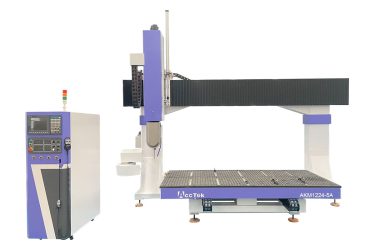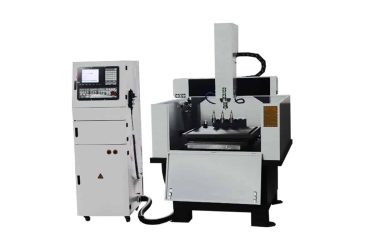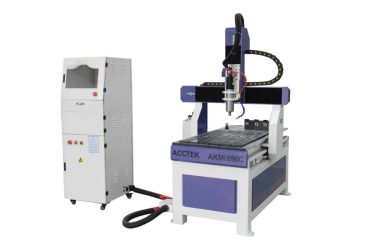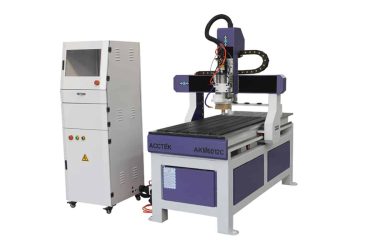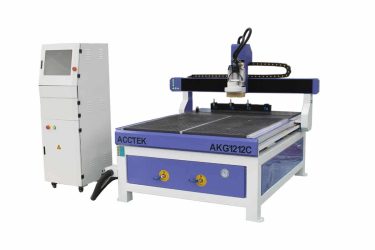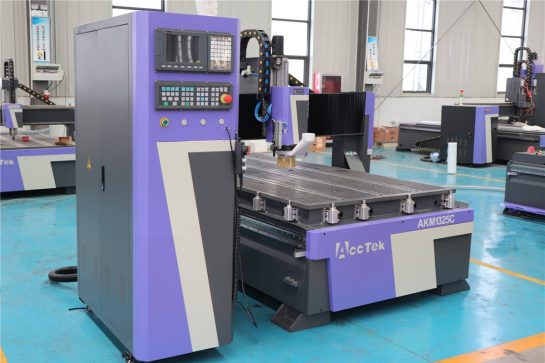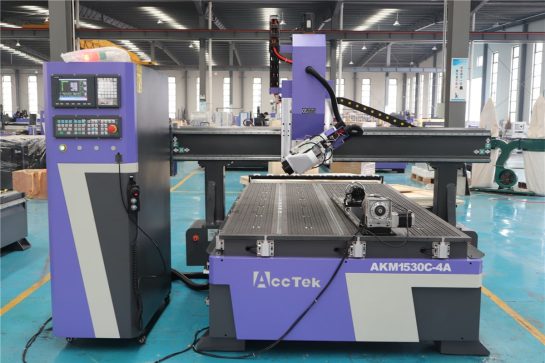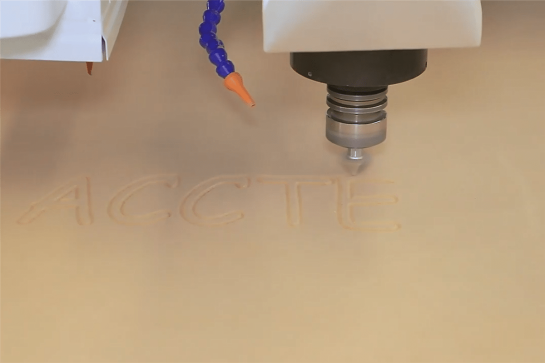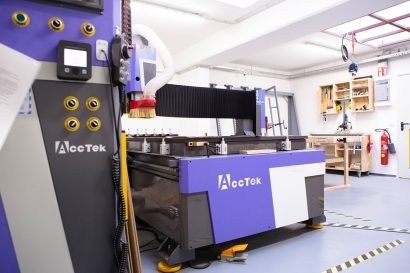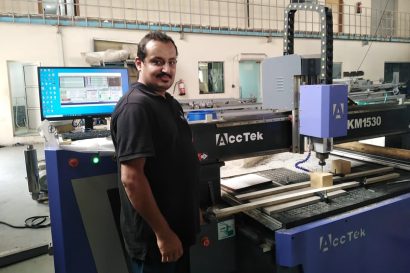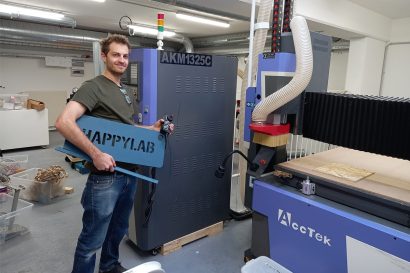ATC CNC Router
The ATC (Automatic Tool Changer) CNC router is a cutting-edge machining system designed for precision and efficiency in various industries including woodworking, metalworking, and plastic manufacturing. This advanced CNC router is equipped with a tool change mechanism that can automatically change tools during processing without manual intervention, reducing downtime.
The ATC CNC router increases productivity by seamlessly switching between different tools, each optimized for specific tasks such as engraving, routing, or drilling. This versatility enables manufacturers to produce complex designs with high precision and speed. ATC systems usually include tool magazines that store various tools, and robotic arms or conveyor belts that quickly select and replace tools as needed. The technology enables companies to streamline production processes, increase yields, and maintain consistent quality in the manufacturing of different materials.
Tips for choosing the right ATC CNC router
Choosing the perfect ATC CNC router can be a game changer in precision manufacturing. In this column, we’ll go over important tips and considerations to help you find the ideal option for your needs. From evaluating spindle power to evaluating software compatibility and considering maintenance support, we’ll explore the important factors that ensure you invest wisely in an ATC CNC router to improve your process and productivity.
Application requirements
Determine the primary materials you will be working with (wood, metal, plastic) and the specific tasks required (cutting, carving, carving). For woodworking you need high precision to account for complex designs, metalworking may require the ruggedness of heavy-duty cutting, and plastics processing may require high-speed capabilities for fine detailing. Determine whether your project involves intricate details, heavy cutting, or a combination of both.
Spindle power and speed
Evaluate spindle power in horsepower (HP) and spindle speed in revolutions per minute (RPM). Higher horsepower enables the cutting of dense materials, while variable speeds accommodate different applications and tools.
Tool capacity and compatibility
Check the ATC tool magazine capacity. Consider the range of tools you need for your project and ensure compatibility with a variety of tool sizes, shapes, and types. Verify that ATC can integrate seamlessly with your existing tool inventory.
speed and accuracy
The accuracy of the machine is evaluated through indicators such as positioning accuracy and repeatability. Additionally, feed rates are analyzed to understand how fast the machine moves during operation. Higher precision and faster feed rates contribute to efficient, precise machining.
Build quality and rigidity
Check the machine’s construction materials and design. The sturdy and durable construction helps minimize vibration, ensure stability during cutting, and improve the overall quality of the finished product. Consider factors such as frame material, bed design, and overall machine weight.
Control System
Evaluate the control system user interface for ease of use, programming capabilities, and compatibility with your workflow. Ensure the control system provides the functionality required for tool path optimization, tool change management, and overall machine control.
Work area size
Determine the required work area based on the size of a typical project. Consider the physical size of the machine and the maximum material size it can hold. Make sure the work area is sized appropriately for your production needs.
Software compatibility
Check your CNC milling machine’s compatibility with computer-aided manufacturing (CAM) software. Ensure your machine supports industry-standard file formats and integrates seamlessly with the software you use to design and generate tool paths, ensuring efficient programming and smooth design execution.
Dust removal system
Evaluate the effectiveness of dust collection systems. A robust system is crucial, especially when working with materials that generate large amounts of dust. An efficient dust collection system maintains a clean work environment, improves air quality, and extends the life of machine components.
Maintenance and support
Ask about the machine’s maintenance requirements and the availability of technical support. Understand recommended maintenance procedures and evaluate the responsiveness of the manufacturer’s support team. A reliable support system minimizes downtime and ensures prompt assistance when needed.
Cost and return on investment (ROI)
Consider the initial cost of the machine relative to its features, capabilities, and expected return on investment. Evaluate how a machine’s efficiency, accuracy, and automation capabilities can increase productivity and cost savings over time.
User reviews and references
Research user reviews and seek references from other businesses or industry professionals who have experience with the specific ATC CNC router model you are considering. Real-world feedback can provide valuable insights into machine performance, reliability, and user satisfaction.
What materials can the ATC CNC router cut?
The ATC CNC router can cut a variety of materials, making it a versatile tool across industries. Some common materials that the ATC CNC router can cut include:
Wood
- Pine
- Oak
- Maple
- Plywood
- MDF
- Cedar
- Teak
Plastics
- Acrylic
- PVC
- HDPE
- LDPE
- Polycarbonate
- PET
- PU
Metal
- Stainless Steel
- Carbon Steel
- Aluminum
- Aluminum
- Copper
- Titanium
- Gold
Others
- Rubber
- Carbon Fiber
- Laminates
- Leather
- Glass
- Stone
- Ceramics
Application Industry

Woodworking Industry
The CNC router is a sophisticated tool that offers unparalleled precision, efficiency, and versatility, redefining what is possible in the world of woodworking.

Advertising Industry
The CNC router excels at carving, engraving, and shaping a variety of materials, from wood and plastic to metal and composites, giving advertisers a canvas as diverse as their imagination.

Bathroom Industry
The CNC router is equipped with advanced computer programming and cutting-edge machinery, ushering in a new era of efficiency, precision, and creativity in the bathroom industry.
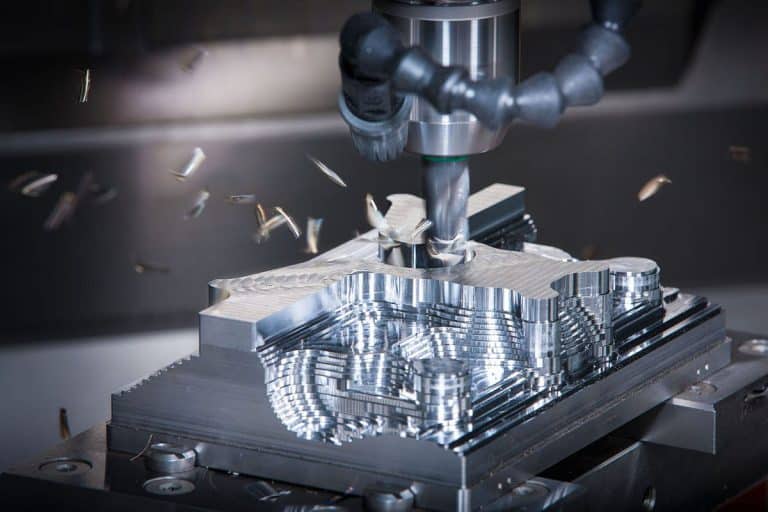
Mold Industry
The CNC router enables manufacturers to create complex, detailed molds with unparalleled precision and speed, making them an indispensable tool in the mold industry.
Blog
A Comprehensive Guide to CNC Router Power Consumption
This guide analyzes the factors that affect CNC router power consumption and provides you with strategies on how to optimize power consumption without affecting productivity and quality.
Read More
What Options Does The CNC Router Support?
In this article, we delve into the diverse range of options that CNC routers support, guiding you toward making informed decisions and achieving remarkable results in your CNC endeavors.
Read More
Can CNC Routers Tackle Any Design Complexity?
CNC routers provide the means to translate designs into physical objects. However, can it tackle any design complexity? Read on to learn about the impact of CNC router performance on ...
Read More
Why Does CNC Router Need To Use A Cooling System?
This article analyzes the CNC router's heat generation to analyze the cooling system's importance in machine operation and provides you with operating precautions for these systems.
Read More
Understanding the Best File Formats for CNC Routers
In the world of CNC machining, the choice of file format holds immense significance. In this guide, we will delve into the intricacies of different file formats to guide you ...
Read More
Is the CNC Router a Product of CAD or CAM?
This article introduces CAD and CAM to you from many aspects, and by exploring its relationship with CNC routers, it answers the question of whether the CNC router is a ...
Read More
Frequently Asked Questions
What does ATC in a CNC Router mean?
ATC stands for automatic tool changer in CNC router. The ATC system is a feature of the CNC router that allows the machine to automatically change tools during machining. This feature eliminates the need for manual tool changes, reduces downtime, and allows the CNC router to perform a variety of tasks without operator intervention, increasing efficiency and productivity.
ATC systems typically involve a tool magazine or carousel that stores multiple tools. These tools vary in type, size and cutting characteristics. The CNC router follows pre-programmed instructions and can automatically select and replace tools from the tool magazine according to the specific requirements of the job. This feature is particularly valuable in applications involving different types of cutting or machining operations within a single project, as it streamlines the entire manufacturing process.
What is an ATC CNC Router?
ATC CNC router is a dedicated CNC router equipped with an automatic tool changer, used for precision machining and manufacturing in various industries. The main feature of the ATC CNC router is its ability to automatically change tools during machining. This automation is achieved through a tool change mechanism, usually in the form of a disc tool changer or a fixed linear tool changer, which can accommodate multiple cutting tools.
The main feature of the ATC CNC router is its ability to accommodate multiple cutting tools simultaneously in the tool magazine or carousel. When the machining program is running, the CNC router automatically selects and replaces tools according to predetermined instructions and tool paths. This seamless tool-changing feature improves efficiency by reducing downtime and increasing productivity, especially in applications requiring a variety of tool types or complex designs.
ATC CNC routers are widely used in industries such as woodworking, metalworking, prototyping and manufacturing for their versatility, precision and ability to handle complex machining tasks. The automatic tool change feature simplifies operation and enables faster, more efficient production while maintaining high levels of accuracy and repeatability.
What are ATC and APC in CNC machining?
In CNC machining, ATC stands for automatic tool changer and APC stands for automatic pallet changer, both of which can improve the efficiency and versatility of the machining process. These systems automate different aspects of the machining process:
- ATC (Automatic Tool Changer): An automatic tool changer is a mechanism in a CNC machine tool (such as a router, lathe, or mill) that automatically changes cutting tools during machining operations. ATC systems are designed to hold multiple tools in a tool magazine or carousel, and the machine’s control system can automatically select and change tools based on programmed instructions. This feature significantly reduces the downtime associated with manual tool changes and enables the machine to perform complex operations using a variety of tools in a single setup.
- APC (Automatic Pallet Changer): The automatic pallet changer is a feature of CNC machining centers that involves the automatic exchange of workpieces or pallets. CNC machines equipped with APC systems have multiple pallets or workpiece holders. While one pallet is in process, other pallets can be loaded or unloaded outside the machine. This enables continuous machining operations and minimizes downtime between setups. APC is particularly useful for high-volume production and is commonly found in machining centers used for tasks such as milling, drilling, and tapping.
What are the different types of ATC in CNC Router?
In CNC routers, automatic tool changer (ATC) systems vary in design and operation to meet different needs and production requirements. Here are some common types of instructions:
- Disc Tool Changer: This type features a rotating disc or turntable with tool slots around its circumference, with the tools held in individual slots. When a tool needs to be changed, the disc rotates to position the designated tool in front of the spindle so it can be retrieved.
- Fixed Linear Tool Changer: In a fixed linear tool changer, the tools are arranged linearly along a fixed track. The spindle moves along this path to select the desired tool. This type is commonly used when space is a concern and it provides a linear and predictable tool change sequence.
- Follow-Up Linear Tool Changer: Similar to the fixed linear tool changer, the follow-up linear tool changer also has the characteristics of the linear arrangement of tools. However, in this system, the tool magazine can move with the movement of the spindle. This helps speed tool changes and reduces idle time.
Why choose ATC CNC Router?
Choosing an ATC (automatic tool changer) CNC router offers manufacturers and machinists multiple advantages, making it a popular choice across various industries. Here are some reasons to consider using an ATC CNC router:
- Improved Efficiency: Automatic tool change significantly reduces downtime between tool changes, maximizing machine uptime and productivity. It simplifies the machining process, allowing for continuous operation without manual intervention.
- Versatility And Flexibility: The ATC CNC router can accommodate multiple tools simultaneously, allowing for versatility in machining operations. This flexibility is especially beneficial for jobs that require different tools or tool changes during a single operation.
- Complexity And Precision: They enable intricate designs and intricate cuts by seamlessly switching between a variety of cutting, engraving, and shaping tools. This results in high precision and accuracy in the final machined product.
- Reduced Operator Intervention: With automated tool changes, the need for manual tool changes is minimized. Not only does this reduce the risk of errors, it also allows operators to focus on other aspects of the production process.
- Consistent Quality: The ATC system enables consistent machining quality by ensuring the right tool is used at the right time. This consistency contributes to a uniform and high-quality finished product.
- Save Time: Eliminate time-consuming manual tool changes, completing machining tasks faster. This time saving is especially valuable in high-volume production environments.
- Adaptability To A Variety of Materials: The ability to switch between different tools makes the ATC CNC router suitable for use with a variety of materials, including wood, plastics, metals, and composites. This adaptability enhances the applicability of CNC routers in different industries.
- Complex Multi-tool Operations: The ATC CNC router is capable of performing complex operations involving the use of multiple tools in a single job. This is beneficial for tasks that require a variety of cutting, engraving, or engraving techniques.
- Optimized Workflow: Automation of tool changes enables a smoother, more optimized workflow. This is especially beneficial in environments where efficiency and accuracy are critical.
- Cost-Effective: Although requiring a higher initial investment, the increased efficiency, reduced labor costs and increased productivity provided by the ATC CNC router can lead to long-term cost savings and a positive return on investment (ROI).
How does the ATC CNC Router work?
ATC (Automatic Tool Changer) CNC router works through a systematic process and allows automatic replacement of cutting tools during machining operations. Here is a general overview of how the ATC CNC router operates:
- Tool magazine or Turntable: ATC CNC router is equipped with a tool magazine or turntable that can accommodate multiple cutting tools. Each tool is secured in a designated slot within the tool magazine.
- Tool Selection: The program of the CNC router specifies the order and time of tool replacement under the guidance of design or processing instructions. Tool paths are programmed to indicate when a specific tool is required for a specific operation.
- Tool Change Command: When the CNC program commands a tool change, the ATC system is activated. Determine the specific tool required for the upcoming operation based on the programmed tool path.
- Tool Retrieval: The tool magazine moves, rotates, or operates according to its design to bring the selected tool within reach of the spindle. The ATC system ensures that the correct tools are provided for retrieval.
- Spindle Operation: The spindle of the CNC router moves to the ATC position. Spindles often have clamps or other mechanisms to securely grip and release the tool.
- Tool Change: The spindle engages the selected tool and removes it from the magazine. The previously used tool is released and placed back into the designated slot in the tool magazine.
- Processing Continues: After fixing the new tool on the spindle, the CNC router will continue the processing process using the updated tool according to the programmed tool path.
- Repeating Process: Throughout the machining operation, the ATC system repeats this process as needed, automatically changing tools to meet the requirements of different cutting, engraving or forming tasks.
How much does an ATC CNC Router cost?
The cost of an ATC CNC router can vary greatly depending on a variety of factors. These factors include the machine’s specifications, features, brand reputation, build quality and size of the work area. In addition, geography and local market conditions can also affect pricing. Here are some general guidelines:
- Entry-level models: Small and lead-screw ATC CNC routers with limited features start at about $8,000 to $10,000.
- Mid-range models: A standard-sized ATC CNC router with moderate tool capacity and additional features may cost between $15,000 and $30,000.
- High-end models: High-end ATC CNC routers are equipped with advanced features, larger work areas, and powerful spindles, and can cost $60,000 or more. Some industrial-grade models can even exceed $100,000.
- Brands And Manufacturers: Well-known and reputable manufacturers may offer pricier machines, but they usually have better build quality, support, and features.
- Size And Work Area: Larger CNC routers with larger work areas tend to be more expensive.
- Tool Capacity And Features: Machines with higher tool capacity and advanced features such as automatic tool measurement, tool breakage detection and dust removal systems may be more expensive.
- Spindle Power And Speed: Machines with more powerful spindles or variable speeds may cost more.
- Control Systems And Software: CNC routers with complex control systems and software compatibility may have a higher price tag.

